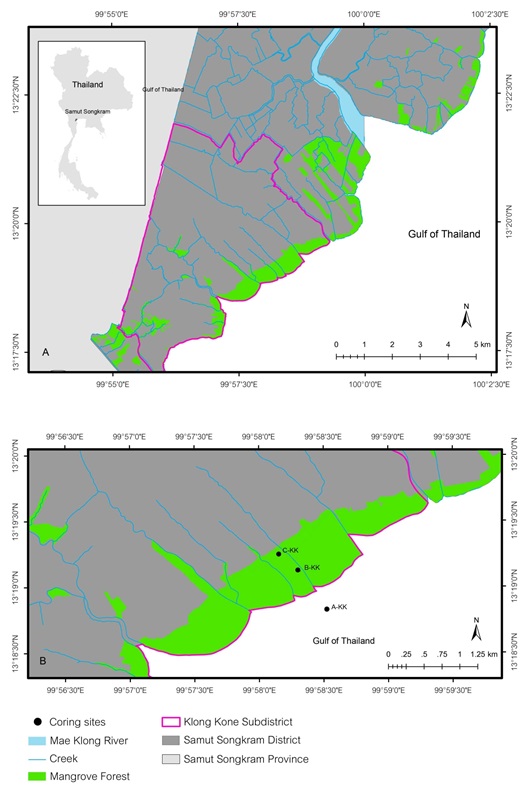Research title: Mangrove Ecosystem-Sea Level-Societal Relationships in the upper Gulf of Thailand during the Holocene: Past Perspectives for Future Sea level Rise Mitigation and Adaptation


Researcher name: Lect. Dr. Paramita Punwong

Figure 1. A type of water dispenser was used in the area of the Mahidol University, Salaya Campus, Thailand.
Coastal habitats, a dynamic environment of key socio-economic importance, comprise biologically diverse ecosystems including mangroves. The mangrove ecosystems, like other coastal habitats, are subjected to sea level fluctuations. In this project mangrove environments are investigated and used to unravel the last 1000-year mangrove dynamics, environmental history and anthropogenic activities of the upper Gulf of Thailand coast. A multiproxy record including pollen, charcoal, loss on ignition and particle size analysis performed on three radiocarbon dated sediment cores taken from two mangrove locations (Klong Kone, Samut Prakan and Bangkhuntien, Bangkok). The results showed that mangroves are dominated by Rhizophora in both areas that indicates these areas have been influenced by sea level from at least 1100 cal B.P. until 700 cal B.P. An intertidal area may have formed that supported mangrove development and may form a part of a palaeo-shoreline in the upper Gulf of Thailand during this period. After 700 cal B.P., mangroves decreased and were replaced by grasses suggesting a lower sea level causing mangroves to retreat seaward until around 200-100 cal B.P. Moreover, cereal pollen increased from around 700 cal B.P. suggesting probable use of the shoreline for human settlement and intensive cultivation. These mangroves were characterised by Avicennia re-colonised toward the top of the three cores, suggesting mangroves retreated landward probably due to recent sea-level rise. Human activity is recorded during the last century in both areas. In addition, the recent sea level rise rate is higher than the past maximum rate of sea level change that mangroves could withstand in the upper Gulf of Thailand. Mangroves in these areas are therefore likely to be vulnerable to sea level rise which management is needed.
ความสัมพันธ์ระหว่างระบบนิเวศ ระดับน้ำทะเล และสังคมในพื้นที่อ่าวไทยตอนบนช่วงสมัยโฮโลซีน: เข้าใจอดีตเพื่อการปรับตัวรับกับระดับน้ำทะเลที่สูงขึ้นในอนาคต
ถิ่นที่อยู่ตามแนวชายฝั่งทะเลเป็นพื้นที่ที่มีความสำคัญทั้งทางเศรษฐกิจและสังคมซึ่งประกอบด้วยระบบนิเวศน์ต่างๆมากมาย รวมทั้งป่าชายเลน ระบบนิเวศน์ป่าชายเลนซึ่งก็เหมือนกันระบบนิเวศน์ชายฝั่งอื่นๆที่มีจะได้รับผลกระทบจากการเปลี่ยนแปลงของระดับน้ำทะเล งานวิจัยครั้งนี้ได้ทำการศึกษาป่าชายเลนเพื่อใช้ในการจำลองสภาพแวดล้อมของพื้นที่ชายฝั่งอ่าวไทยตอนบนในช่วง 1000 ปีที่ผ่านมา โดยอาศัยการศึกษาจากการวิเคราะห์เรณู ถ่านไม้ มลทินที่หายไปหลังการเผา และขนาดของตะกอนในตะกอนป่าชายเลนจากคลองโคน สมุทรสงครามและบางขุนเทียน กรุงเทพฯ ซึ่งใช้ในการศึกษาการเปลี่ยนแปลงพืชพรรณของป่าชายเลน การเปลี่ยนแปลงสภาพแวดล้อม และกิจกรรมมนุษย์ ผลจากการศึกษาพบว่าป่าชายเลนซึ่งมีโกงกางเป็นไม้เด่น ได้เข้าครอบครองพื้นที่ทั้งในคลองโคนและบางขุนเทียนซึ่งบ่งบอกว่าพื้นที่เหล่านี้ได้รับอิทธิพลจากน้ำทะเลทั้งแต่ 1100 – 700 ปีก่อนปัจจุบัน ในช่วงเวลาดังกล่าว พื้นที่เขตชายฝั่งทะเลเหล่านี้เกิดขึ้นและน่าจะเป็นส่วนหนึ่งของชายฝั่งโบราณของอ่าวไทยซึ่งเป็นพื้นที่ที่เอื้อต่อการเจริญของพืชพรรณป่าชายเลน หลังจากนั้นจนถึงช่วง 200-100 ปีก่อนปัจจุบัน พืชพรรณป่าชายเลนลดลงและถูกแทนที่ด้วยพืชจำพวกหญ้า ซึ่งบ่งบอกถึงการถดถอยของระดับน้ำทะเลและทำให้ป่าชายเลนถอยร่นไปยังชายฝั่งทะเล นอกจากนี้ในช่วง 700 ปีก่อนปัจจุบัน เรณูของธัญพืชได้เพิ่มจำนวนมากขึ้นซึ่งน่าจะชี้ให้เห็นถึงการตั้งถิ่นฐานของมนุษย์และการเกษตรกรรม ป่าชายเลนได้เพิ่มจำนวนมากขึ้นโดยเฉพาะพืชจำพวกแสมในช่วงบนของตะกอนบ่งบอกถึงการถอยร่นเข้าไปยังแผ่นดินของป่าชายเลนซึ่งน่าจะเกิดจากระดับน้ำทะเลที่เพิ่มสูงขึ้นในช่วงปัจจุบัน ทั้งนี้ในช่วง 100 ปีสุดท้ายได้มีหลักฐานที่บ่งชี้ถึงกิจกรรมมนุษย์ในพื้นที่เหล่านี้ด้วย นอกจากนี้อัตราการเพิ่มขึ้นของระดับน้ำทะเลปัจจุบันในอ่าวไทยตอนบนนั้นมีค่ามากกว่าอัตราที่สูงที่สุดที่ป่าชายเลนยังคงอยู่ได้ในอดีต ดังนั้นป่าชายเลนในพื้นที่เหล่านี้มีความเป็นไปได้ว่าจะมีความเปราะบางต่อระดับน้ำทะเลที่สูงขึ้นจึงต้องมีการจัดการพื้นที่ป่าชายเลนเหล่านี้ในอนาคต
